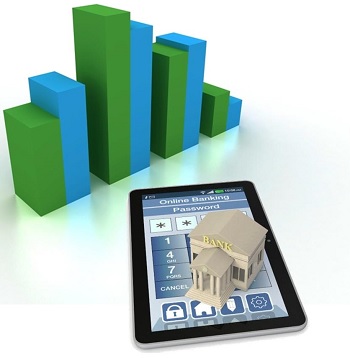The results of recent research show that a notable percentage of smartphone users use the device to conduct financial transactions.
A recent survey conducted by a financial analytics firm called RateWatch has shown that while a very small percentage of bank customers consider mobile banking to be their main option, accessing an account via smartphone is highly popular nonetheless.
Among the survey participants, 62 percent considered their primary option to be banking in person at the branch.
The 4th Annual Mobile Banking Survey revealed that while people may not think of their mobile devices as their main method of banking, there is still a considerable number of them who actually use those devices for that purpose. Bain & Co., a global management consultancy, conducted a survey that showed that 35 percent of customers worldwide were using their smartphones in order to complete certain bank transactions. That research involved the responses from approximately 83,000 bank account owners.
The popularity of mobile banking is reflected in the changes that many banks are making to cater to the devices.
 Chase Bank, for example, was one of the early entrants into the world of apps and services over mobile devices. This financial institution not only created applications that could be used by customers in order to complete transactions with their bank, but it also advertised it quite heavily through various different kinds of ads. That bank currently has over 18 million mobile customers, according to the figures cited by Gavin Michael, the Chase Bank head of digital.
Chase Bank, for example, was one of the early entrants into the world of apps and services over mobile devices. This financial institution not only created applications that could be used by customers in order to complete transactions with their bank, but it also advertised it quite heavily through various different kinds of ads. That bank currently has over 18 million mobile customers, according to the figures cited by Gavin Michael, the Chase Bank head of digital.
Michael explained that the use of smartphones to complete these transactions is “redefining how we think about banking”. This same attitude appears to be shared by the entire banking industry, at the moment. The survey from RateWatch suggested that from 2011 to 2014, the percentage of banking institutions that started to offer services over mobile devices doubled from having been 41 percent to become 82 percent.
Mobile banking has faced a number of hurdles along the way – and continues to do so. At the same time that its convenience has made it increasingly popular among some consumers, there are many who are highly resistant to using it due to concerns with regards to the security of their devices and the safety of their private and sensitive data.
These mobile devices are certainly becoming more popular, but many consumers wonder if they come with medical risks.
The last several months has represented an extremely important time for the release of various types of wearables as well as for the very beginning of consumer adoption, but as was the case with the penetration of cell phones and smartphones, consumers are now wondering if these devices will be safe for their health.
Unlike traditional smartphones, wearable technology is worn on the clothing or body all the time.
Tech companies and fashion brands, alike, have been stretching their creativity to the outer extent in the hopes of coming up with a type of wearables that would truly appeal to consumers and that they would want to be able to purchase so that they can wear them all the time. Many predictions have showed that this industry has tremendous potential, as the market will grow to about $50 billion over the next three to five years. That would represent a market increase of about ten times where it was in 2014. The release of the Apple Watch in the first quarter of 2015 expected to drive that growth quite powerfully.
Wearables may present a technology and financial opportunity, but the health consequences have not yet been thoroughly examined.
 Recently, at the New York Times International Luxury Conference session on wearable technology, there was a great deal of repetition when it came to the main topics surrounding these gadgets, but the only one on a considerable panel of participants to discuss the actual safety of the devices was Diane von Furstenburg, the fashion designer. She was the only one to raise that topic throughout the entire event.
Recently, at the New York Times International Luxury Conference session on wearable technology, there was a great deal of repetition when it came to the main topics surrounding these gadgets, but the only one on a considerable panel of participants to discuss the actual safety of the devices was Diane von Furstenburg, the fashion designer. She was the only one to raise that topic throughout the entire event.
As much as is it is important to discuss its opportunity as a product, whether or not it is useful, if it is affordable for the average consumer, and whether or not it is stylish, knowing if it is safe to actually wear these mobile devices on our bodies at all times is an important consideration. After all, many smartwatches and health trackers are worn at all times, including throughout sleep. Augmented reality headset wearables are worn throughout the day right on the head. This is a great deal more exposure than a smartphone, which is often put down, when it is not in use.
As wearables become increasingly popular throughout this year and become mainstream in the near future, it is more than likely that health and safety risks will become a rising topic of discussion and an important trend to watch.
 Chase Bank, for example, was one of the early entrants into the world of apps and services over mobile devices. This financial institution not only created applications that could be used by customers in order to complete transactions with their bank, but it also advertised it quite heavily through various different kinds of ads. That bank currently has over 18 million mobile customers, according to the figures cited by Gavin Michael, the Chase Bank head of digital.
Chase Bank, for example, was one of the early entrants into the world of apps and services over mobile devices. This financial institution not only created applications that could be used by customers in order to complete transactions with their bank, but it also advertised it quite heavily through various different kinds of ads. That bank currently has over 18 million mobile customers, according to the figures cited by Gavin Michael, the Chase Bank head of digital.
 Recently, at the New York Times International Luxury Conference session on wearable technology, there was a great deal of repetition when it came to the main topics surrounding these gadgets, but the only one on a considerable panel of participants to discuss the actual safety of the devices was Diane von Furstenburg, the fashion designer. She was the only one to raise that topic throughout the entire event.
Recently, at the New York Times International Luxury Conference session on wearable technology, there was a great deal of repetition when it came to the main topics surrounding these gadgets, but the only one on a considerable panel of participants to discuss the actual safety of the devices was Diane von Furstenburg, the fashion designer. She was the only one to raise that topic throughout the entire event.